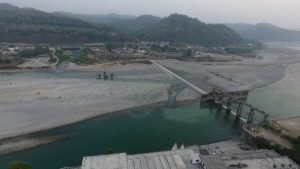The Yamuna River, once a revered and life-giving force, is now gasping for breath under the strain of unchecked pollution. At the heart of this crisis lies the role of industries. While these industries drive economic growth and provide livelihoods to millions, they also contribute significantly to the degradation of one of India’s most important rivers. The question we must ask ourselves is this: how can we balance industrial development with the health of the Yamuna?
This is not just an environmental issue; it’s a matter of survival—for the river, the ecosystems it supports, and the communities that depend on it.
Industries and the Yamuna: A Troubled Relationship
Northern India’s industrial belt thrives along the Yamuna. From textile factories to pharmaceutical plants, industries rely heavily on the river for water supply, waste disposal, and transportation. But this dependence comes at a steep price.
- Untreated Wastewater: Many industries discharge untreated or inadequately treated effluents into the Yamuna. This wastewater is loaded with harmful chemicals, dyes, heavy metals, and oils, turning the river into a toxic sludge.
- Over-Extraction of Water: Industries withdraw massive amounts of water for their operations, depleting the river’s natural flow. Without adequate flow, the river loses its ability to dilute pollutants, exacerbating its pollution levels.
- Solid Waste Dumping: Beyond liquid waste, industries also contribute to solid waste pollution. Plastics, packaging materials, and industrial by-products often find their way into the riverbanks and waters.
- Airborne Pollution Fallout: Industrial emissions don’t just pollute the air—they settle into the river as well, either directly or through rainwater runoff.
The Ripple Effects of Industrial Pollution
The industrial pollution of the Yamuna doesn’t just harm the river; its effects ripple outward, impacting every aspect of life connected to it.
- Human Health Crises: People who rely on the Yamuna for drinking, cooking, and bathing are exposed to a toxic cocktail of contaminants. The result? Widespread cases of waterborne diseases like typhoid and cholera, long-term health problems like cancer and kidney damage, and rising cases of skin and eye infections.
- Collapse of Aquatic Life: The toxic waste entering the river reduces oxygen levels, creating zones where fish and other aquatic organisms cannot survive. The once-thriving biodiversity of the Yamuna is now hanging by a thread.
- Farmlands in Jeopardy: Farmers who irrigate their fields with Yamuna water unknowingly introduce harmful chemicals into the soil, reducing crop quality and fertility. These pollutants also enter the food chain, impacting human health on a broader scale.
- Ecosystem Destruction: The Yamuna’s wetlands and surrounding ecosystems, which act as natural filters and habitats for diverse species, are being destroyed by industrial encroachments and pollution.
Why Industries Must Step Up
Industries are a significant part of the problem, but they also hold the power to be part of the solution. They rely on the Yamuna for water, transportation, and waste disposal, and it’s in their best interest to ensure the river remains a sustainable resource.
Moreover, public scrutiny and government regulations are increasing, making it not just a moral obligation but also a smart business move for industries to adopt sustainable practices.
Finding Sustainable Solutions
Restoring the Yamuna requires a comprehensive, collaborative approach where industries play a leading role. Here are some actionable solutions:
- Cleaner Production Techniques: Industries must invest in modern, eco-friendly technologies that reduce waste generation and energy consumption. Water-efficient processes and the use of non-toxic raw materials can significantly reduce their environmental footprint.
- Effluent Treatment Plants (ETPs): Setting up and maintaining advanced ETPs should be non-negotiable for all industries. These plants ensure that wastewater is treated to safe levels before being discharged into the river.
- Zero-Liquid Discharge (ZLD) Policies: Industries can adopt ZLD systems, which recycle and reuse wastewater within their operations, ensuring nothing harmful reaches the Yamuna.
- Regular Monitoring and Audits: Continuous monitoring of industrial discharges through IoT-based sensors and third-party audits can help identify pollution sources and ensure compliance with regulations.
- Corporate Social Responsibility (CSR) Initiatives: Industries can channel their CSR funds into river cleanup projects, community awareness programs, and restoration of wetlands and riverbanks.
- Government-Industry Partnerships: Governments can collaborate with industries to create incentives for sustainable practices, such as tax breaks or subsidies for adopting clean technologies.
The Role of Individuals and Communities
While industries bear significant responsibility, individuals and communities also have a role to play. Public pressure can be a powerful tool in holding industries accountable. Supporting sustainable businesses, reducing personal waste, and participating in cleanup drives can make a difference.
The Yamuna’s condition is a wake-up call for all of us. Industrial pollution has pushed the river to the brink, but there’s still hope. With the right mix of technology, policy, and public will, we can chart a sustainable path forward.
Industries have the expertise, resources, and influence to lead this transformation. By embracing sustainability, they can protect the Yamuna and ensure their long-term growth and societal goodwill. The time to act is now—for the river, for the communities it supports, and for the future we hope to build.
The Yamuna isn’t just a resource—it’s a shared responsibility. Together, we can ensure that this lifeline of Northern India flows clean and free once again.


